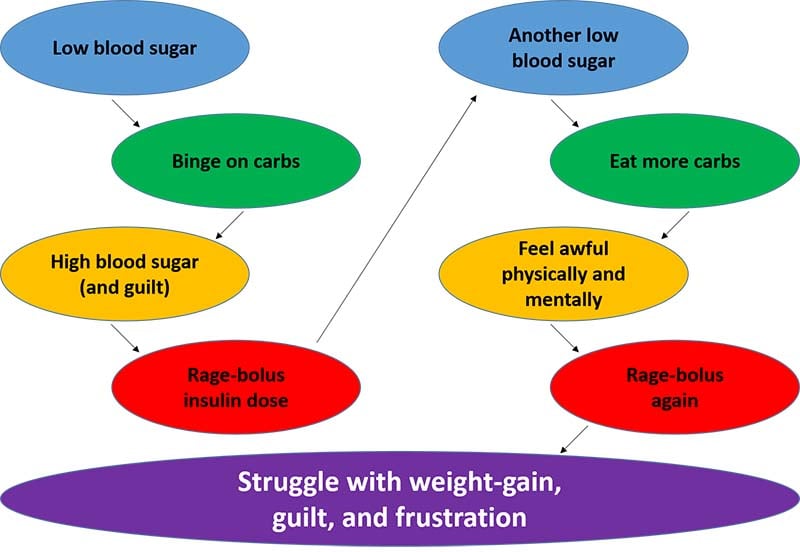A habit of binge-eating during low blood sugars can wreak havoc on your blood sugar levels, your energy, your weight, and your daily life.
The blood sugar roller coaster that often accompanies over-eating during hypoglycemia is exhausting.
In this article, we’ll discuss how to stop the cycle and habit of binge-eating during low blood sugars.
What is hypoglycemia?
In the human body, a blood sugar level below 70 mg/dL will interfere with your brain and your entire body’s ability to function properly. Even the most basic tasks, like walking or speaking, can become extremely difficult the lower your blood sugar drops below 70 mg/dL.
Your brain relies on a second-by-second delivery of glucose from your bloodstream in order to function. Without enough glucose (sugar) in your bloodstream, your brain and entire body will struggle to function.
The intense food cravings during a low blood sugar are really coming from your brain, pleading, “Feed me! Feed me!”
Left untreated, low blood sugars can lead to seizures and death.
Here are 5 steps to stopping the habit of binge-eating during low blood sugars.
- Identify the symptoms of your low blood sugar
- Acknowledge your current habit (and its consequences) around lows and food
- Choose 3 specific fast-acting carbohydrates as your primary treatment for lows
- Distract yourself with something else…
- Reinforce this mantra: “I do have control over what I eat when I’m low.”
Let’s take a closer look.
Identify the symptoms of that specific low blood sugar
Hunger is one of the many telltale signs that your blood sugar has dropped below a safe level, but it’s important to identify other symptoms of low blood sugar to help reinforce good habits around how you treat low blood sugars in general.
By identifying the symptoms that you personally experience during a low blood sugar, you’re reminding yourself that those intense cravings for food aren’t random or normal hunger, they are directly tied to your blood sugar, and they aren’t rational.
The American Diabetes Association (ADA) lists the following as symptoms of low blood sugar:
- Hunger
- Feeling shaky
- Being nervous or anxious
- Sweating, chills, and clamminess
- Irritability or impatience
- Confusion
- Fast heartbeat
- Feeling lightheaded or dizzy
When you do notice your blood sugar is low, take just 20 seconds to identify your symptoms — including those severe cravings — and remind yourself they are an irrational aspect of hypoglycemia.
Yes, you need some food, but you don’t need all the food.
Acknowledge your current habit (and its consequences) around low blood sugars and food
Routinely binge eating during low blood sugars comes with some not-so-subtle consequences. And a big part of breaking that binge-eating habit comes down to fully acknowledging it.
You could write it down, make a YouTube video, or record a voice-memo about that you send to your mom — whatever works for you! The goal is to simply look at the habit and the vicious cycle it creates from a distance.
Things to consider…
- How many extra calories do you consume every day or week because of binge eating during lows?
- How much is it contributing to gradual weight gain?
- How often does it send your blood sugar skyrocketing up to 300 mg/dL, followed by a “rage bolus,” which leads to another exhausting low blood sugar?
- How much does it impact your work, school, and relationships?
- How much does it impact your self-esteem?
- How much shame or regret do you feel after binge eating?
- How does it affect your relationship with food at other times of the day?
Here’s a simple look at the binge-eating cycle around low blood sugars in my book, “Emotional Eating with Diabetes”:

Choose 3 specific fast-acting carbohydrates as your primary treatment for lows
If you aren’t prepared to treat low blood sugars with something specific, it’s easy to grab anything and everything and thus, have no limits around it.
By choosing 3 specific fast-acting carbohydrates to stock up on and use for treating lows, you will ensure:
- that you’re always prepared (Gummy Lifesavers, for example, survive in hot and cold temperatures, only require 3 or 4 to treat the average low, and one bag can treat dozens of lows).
- that you can control exactly how many grams of carbohydrates you consume. Mild lows may only need 6 to 8 grams of carbohydrates, while severe lows may need 15 to 20 grams.
- that you’re consuming something that digests easily and quickly. Using high-fat or high-protein foods to treat lows will only make your symptoms and cravings last longer.
- that you’re consuming “medicine food.” Whichever 3 foods you choose (for example jelly beans, juice box, fruit snacks), you can think of those things as “medicine foods.”
- you won’t use lows as an excuse to binge-eat yummy treats like brownies or ice cream. Instead, give yourself permission to eat those treats in a more controlled environment when your blood sugar and your appetite are rational and stable.
When you choose fast-acting carbohydrates like fruit snacks, jelly beans, gummy Lifesavers, Smarties, glucose tabs, etc. to treat lows, you can prepare by storing them in your purse, desk, backpack, nightstand, gym bag, jacket pocket, and glove compartment in your car.
The more you are prepared for treating lows properly, the more easily you’ll be able to manage them properly, too!
Distract yourself with something else…
Of course, we all know the symptoms of low blood sugar can persist long after your blood sugar has risen to a safe level. And of course, extreme hunger is one of the most persistent symptoms (followed by the desperate desire for a cozy nap!)
This means that after you treat the low, you need to distract yourself with something until those intense cravings for more food quiet down and disappear.
You may find that simply noshing on something like gum or carrots can provide that satisfying feeling to your brain because you’re chewing without consuming starchy carbohydrates.
Here are a few distraction techniques:
- Chug some ice-cold water
- Chew on carrots or celery
- Pop some gum or TicTacs
- Record a voice memo to yourself about your ability to control what you eat
- Clean your kitchen
- Squeeze a stress ball
- Lie down in bed and close your eyes
The goal is to either distract your mouth or your hands or both!
Reinforce this mantra: “I do have control over what I eat when I’m low.”
Truly, the biggest contributor to your habit of binge eating during low blood sugars is the belief that you have no control over what you’re doing. That you are helplessly putting more food in your mouth because your brain is desperately begging for more
But you do have control. You do have rational thought and logic and reason at your disposal, you just have to make the choice to use those things.
Sure, I’d like to eat 3 bowls of Honeycombs mixed with Peanut Butter Captain Crunch every time my blood sugar dips below 50 mg/dL, but I know what that will do to the rest of my day, to my blood sugar, to my energy, and how guilty and regretful I’ll feel because of those things.
If you continue to tell yourself you have no control over how much you eat during lows or that you deserve to eat as much as you want during lows, then you’ll continue to feed that belief and that vicious habit.
If you take a moment to remind yourself, “I do have control over what I eat when I’m low,” you will be taking responsibility for how you treat lows and for your actions in general.
It’s actually pretty darn empowering. And quite rewarding, because treating a low with a reasonable amount of fast-acting carbohydrates means bringing your blood sugar up to a reasonable blood sugar level.
This means you don’t have to deal with a blood sugar roller coaster and the guilt of overeating. Instead, you get to continue with your day, proud of your ability to exert control over your own behavior.
Self-discipline produces…pride. Low blood sugars could become a source of pride and integrity in how you manage your health. And that could easily start to spill over into other areas of your health, too.




Steve Hilton
Thank you so much for your clear, concise teaching, and your down to earth suggestions. I found your site after coming off a 2-3 hour binge, while waiting for supper to be made. 4 1/2 hours later, my blood sugar is 398, and I came to my senses and realized what I was doing to myself. Your 5 steps are so clear, and so encouraging. I’m 57 years old, and have been dealing with Type 2 diabetes for about 8 years.
Jay
Good day, I know the article is a bit old.
Brief history of me, Type One Diabetic for roughly 52 years. No known long term complications, thankfully. HBAC1 normally within range.
On a one to one ratio, so one gram of carbs, one unit Humalog.
This overdosing, apologies, don’t buy it. All you have to do is work out how much insulin you need, start small, test two hours later, no more hypos, simples.
Kathy
Hi, I am surprised the ADA doesn’t list weakness as a sign of low BG. I have had Type I for over 50 years, and my main symptom of low BG is weakness and lethargy. Then again, I am an active person and likely am out doing something physical at the time my BG is low. Thanks for your amazing articles.
Kerri
This was amazing and I can’t express how much this has helped me. God bless you ?
Larry Shaw
Thank you for writing down things that I’ve known to be true, but just haven’t been able to put all the pieces together. As a Type 1 diabetic for 20+ years, I’ve seen my weight creep up year after year, due in large part to this exact issue!
You nailed it – thanks again!
Christel Oerum
Thank you Larry – I completely agree, sometimes we kind of know what’s going on but seeing it in writing or discussing it with someone makes it more real